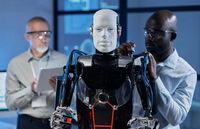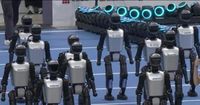At Beijing’s National Speed Skating Oval, an extraordinary spectacle is unfolding: the first-ever World Humanoid Robot Games, a three-day event that has brought together more than 500 humanoid robots from 280 teams representing 16 countries, including the United States, Germany, Japan, Brazil, and, of course, China. The games, which kicked off with a dazzling opening ceremony on August 14, 2025, and run through August 17, have already captured the imagination of spectators and tech enthusiasts alike.
The opening ceremony was anything but ordinary. According to the Associated Press, humanoid robots wowed the crowd with hip-hop dance routines, martial arts displays, and even live music performances on keyboard, guitar, and drums. The robots didn’t just stick to the stage—some strutted down the runway modeling fashionable hats and clothes alongside human models, though not without a few mishaps. One robot model, after taking a tumble, had to be carried off the stage by two human assistants. It was a reminder that, as advanced as these machines are, they’re still learning to walk (and strut) before they can run.
As the games officially began on August 15, the competitive spirit was palpable. Robots—each required to have a trunk, upper limbs, and two feet, and to be self-developed, purchased, or leased by their teams—lined up for events ranging from soccer and running to boxing, martial arts, gymnastics, track and field, and table tennis. The diversity of events, as reported by Reuters and NBC News, underscored the organizers’ goal: to create a showcase that not only highlights technical prowess but also accelerates the integration of robots into human life, blending science, technology, sports, and culture.
Teams hail from a broad spectrum of backgrounds. There are squads from elite Chinese universities such as Tsinghua University and Peking University, robotics companies from around the globe, and even three middle schools. Government agencies and private firms are also in the mix, reflecting the broad interest in humanoid robotics across sectors. The field is international, with teams from the U.S., Japan, Germany, and Brazil all vying for medals and, perhaps more importantly, bragging rights in this rapidly evolving technological arena.
The games have not been without their memorable moments. During the opening night, a robot soccer player scored a goal after several tries, sending the opposing goalkeeper robot tumbling to the ground—a scene that drew laughter and applause from the audience. Yet another robot, after falling, managed to stand up unassisted, a small but significant triumph in the world of robotics. As NBC News captured, these events are as much about resilience and learning as they are about competition. Sometimes, even the best robots take a spill.
But why pit robots against each other in sports? As Max Polter of the HTWK Robots football team from Leipzig University of Applied Sciences in Germany explained to Reuters, “You can test a lot of interesting, new and exciting approaches in this contest. If we try something and it doesn’t work, we lose the game. That’s sad, but it is better than investing a lot of money into a product that fails.” In other words, the games serve as a real-world laboratory, allowing teams to test ideas and algorithms under pressure, and to push the limits of what their creations can do.
These competitions also have broader implications. Sports like soccer require robots to coordinate with each other, a skill that translates directly to industrial settings—think factory robots working in tandem on an assembly line. The games, then, are not just about entertainment or spectacle; they’re a proving ground for the next generation of industrial and service robots.
China’s commitment to robotics and artificial intelligence is unmistakable. The World Humanoid Robot Games come at a time when the country is investing heavily in these fields, eager to lead in the global tech race. As China’s official newspaper People’s Daily quoted a Beijing government officer, “every robot participates is creating history.” The sentiment is echoed by the tournament’s organizers, who stated, “By establishing a competitive and showcase platform, the tournament aims to accelerate and enhance the integration of robots into human life, contribute to economic and social progress, and foster the deep integration of science, technology, sports, and culture.”
This event also takes place against the backdrop of an intensifying technological rivalry between China and the United States. Humanoid robots are increasingly seen as a new battleground in this competition, with both nations eager to demonstrate their prowess in artificial intelligence and robotics. Recent months have seen robots racing against humans in a Beijing half-marathon and the opening of a consumer robot store in the city. Meanwhile, American tech giants are making their own moves: Tesla has showcased its Optimus robot, NVIDIA has launched the Isaac GR00T N1 foundation model for robotic reasoning, and Hugging Face began selling its $3,000 HopeJR humanoid robot in May. Even Intel has spun out its humanoid robot division, backed by $50 million in funding this July.
Yet, as much as the games are about the future, they also build on a rich history of robotics competitions. Back in 2015, South Korea’s Team KAIST won the DARPA Robotics Challenge, a contest designed to test robots’ ability to operate in disaster relief scenarios. The World Humanoid Robot Games in Beijing are the latest in this lineage, but with a distinctive focus on humanoid forms and public spectacle.
Tickets for the event have been snapped up by curious members of the public, with prices ranging from 180 yuan (about $25) to 580 yuan (roughly $80). The appeal is obvious: where else can you watch robots box, dance, and play soccer—sometimes with surprising skill, sometimes with endearing clumsiness?
The first gold medal of the competition was awarded to Unitree Robotics, whose Unitree H1 humanoid robot captured the top spot in the 1,500-meter race with a time of 6 minutes and 34 seconds. The winning robot stood proudly on the podium, flanked by its team of human operators—a fitting emblem of the partnership between human ingenuity and machine capability that defines the event.
As the games draw to a close on August 17, the legacy of the first World Humanoid Robot Games is already taking shape. It’s a testament to how far robotics has come—and a tantalizing glimpse of where it might go next.





